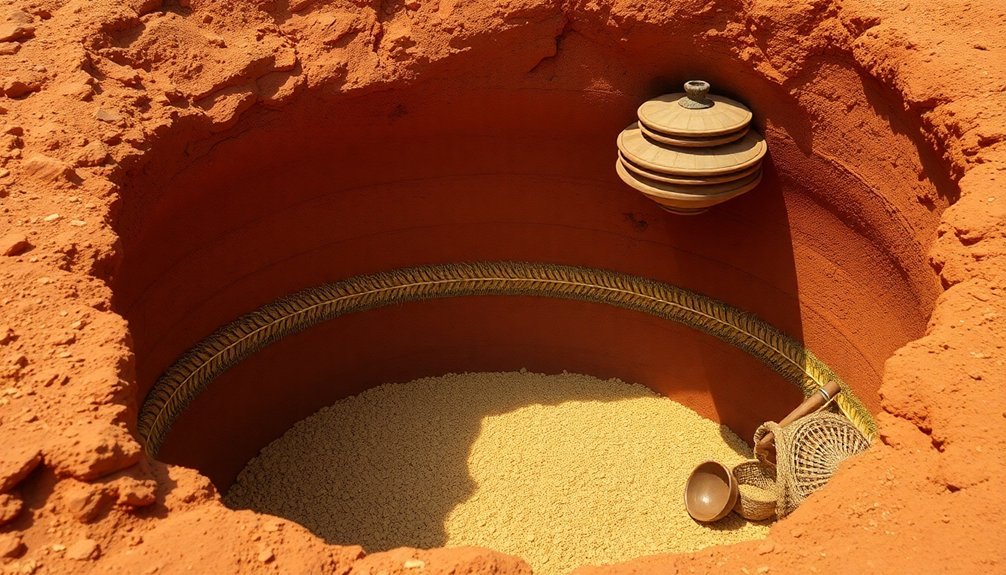Desert cultures store grains exceptionally well because they've mastered techniques that work perfectly with their environment. You'll find their storage methods take full advantage of naturally low humidity and cool night temperatures, which help prevent spoilage and pest problems. They use everything from underground silos to elevated platforms, and they've perfected construction techniques using local materials like clay and stone. Their methods include airtight sealing, strategic placement in shaded areas, and smart moisture control. You'll discover these time-tested practices reflect generations of knowledge that's still relevant today.
Ancient Desert Storage Wisdom

Three key principles guided ancient desert civilizations in their grain storage methods: protection, preservation, and security. You'll find these principles masterfully applied in their innovative storage designs, from circular silos to underground chambers.
When you examine ancient desert storage facilities, you'll notice they weren't built haphazardly. They constructed circular silos with internal levels that kept grain elevated and safe from weather damage and pests. They'd often build multiple silos rather than one large facility, making it harder for thieves to access the entire grain supply at once. Just three weeks of harvesting and proper storage could provide food for a year for a family of four.
You can see their ingenuity in preservation techniques too. They'd create underground storage systems like the Egyptian "shuna" that maintained steady temperatures and humidity levels. They'd also use storage pits that created anaerobic conditions, effectively preserving grain while hiding it from potential thieves.
The most fascinating security measures included elaborate designs like the Minoan labyrinths, specifically created to confuse and trap intruders. They'd also place granaries above ground level to deter rodents and employ domesticated cats as natural pest control.
These methods guaranteed their precious grain supplies remained safe and edible for extended periods.
Natural Climate Advantages
Natural conditions in desert regions consistently provide unique advantages for grain storage that ancient civilizations cleverly exploited.
You'll find that desert climates naturally maintain low humidity levels, which considerably reduces the risk of moisture-related spoilage and mold growth that typically plague grain storage in other regions.
Desert temperatures, while hot during the day, drop considerably at night, creating natural temperature regulation cycles.
You're getting a double benefit here: the cool nights help prevent insect infestations since temperatures often fall below 60°F, reducing insect reproduction rates or even forcing them into dormancy.
The low moisture content in desert air also means you don't have to worry as much about condensation and moisture migration within storage containers.
In semi-arid and Mediterranean climate zones, you'll notice that southern sites experience higher temperatures and lower humidity. This natural environment helped prevent the 50% crop losses that were common in more humid regions throughout history.
While high temperatures can reduce storage time, desert cultures developed methods to combat this by using well-ventilated storage areas and positioning storage units to maximize natural cooling effects.
The stable, predictable nature of desert weather patterns also makes it easier to maintain consistent storage conditions year-round.
Underground Storage Solutions

Delving deep beneath the desert sands, ancient cultures mastered the art of underground grain storage through ingeniously designed silos and pits. You'll find that these underground storage solutions were more than just holes in the ground – they were sophisticated systems that protected grain without using any energy or modern chemicals. These storage pits were especially effective since they maintained minimal issues with rodents compared to above-ground alternatives.
| Storage Aspect | Ancient Method | Modern Equivalent |
|---|---|---|
| Pest Control | Airtight sealing | Chemical pesticides |
| Temperature | Natural ground cooling | Powered ventilation |
| Humidity | Clay-lined walls | Climate control |
When you examine these ancient storage methods, you'll notice they relied on simple yet effective principles. The pits were carefully shaped and sized, often grouped together in dedicated storage areas. You'd be amazed to learn that these underground silos maintained grain quality so well that they preserved both germination properties and food safety standards. Today's researchers are recreating these pits through projects like SilArchaeoBio, equipping them with modern monitoring devices to understand how they work. What's particularly interesting is that you can adapt these time-tested techniques for modern sustainable agriculture, offering solutions that don't require extensive energy use or chemical treatments.
Solid Wall Construction Methods
Traditional solid wall storage bins showcase remarkable engineering adaptations to desert environments, utilizing locally sourced materials and time-tested construction techniques.
You'll find these structures built during dry weather conditions, featuring clay walls that range from 15-20 cm thick in West Africa, though they can be as thin as 2.5-5 cm when reinforced.
The design principles you'll encounter focus on both durability and pest prevention. You'll notice smooth interior and exterior surfaces that deny insects refuge, while internal compartments and central columns provide essential structural support.
Before loading grain, you'll need to seal any fissures with liquid clay to maintain the bin's integrity.
Modern variations like the "Pusa" and "Burkino" silos have evolved from these traditional methods.
You'll see how they've incorporated stabilized earth bricks, concrete pillars, and cement plastering reinforced with chicken wire mesh. The walls are often wrapped with polyethylene sheets to control moisture, while dome-shaped tops with central openings allow easy access.
Whether you're using traditional clay or modern ferrocement, you'll find that proper construction techniques guarantee effective grain preservation in desert conditions.
Temperature Management Benefits

Effective temperature control stands as a cornerstone of successful grain storage in desert environments. You'll find that desert cultures have long understood the importance of maintaining ideal temperatures between 35-45°F (2-7°C) for their stored grains, particularly when managing moisture content at 13-14%.
Desert storage methods naturally align with these requirements, as the climate's dramatic day-night temperature swings help regulate grain temperatures.
The benefits of desert grain storage include natural temperature management through:
- Bottom-to-top airflow patterns that mimic traditional aeration systems, ensuring uniform cooling throughout stored grain masses
- Dry ambient conditions that help maintain lower moisture content, reducing the risk of spoilage and extending storage life from 30 to 240 days
- Natural cooling cycles during nighttime hours that achieve the same effects as mechanical aeration
You'll need to monitor your grain regularly, even in desert conditions. Using probe traps and temperature sensing tools helps you detect any potential issues early.
When you're storing grain in desert environments, you're taking advantage of natural temperature fluctuations that help prevent moisture migration and reduce the risk of grain deterioration, making these traditional storage methods particularly effective.
Moisture Control Techniques
While temperature control plays a vital role in desert grain storage, moisture management requires equally sophisticated techniques that desert cultures have mastered over generations.
You'll find solid wall bins prevalent in places like the Sahel region and areas bordering the Kalahari desert, where these structures can last up to 50 years when properly maintained.
You can observe how desert communities use sealed containers masterfully, particularly large clay jars with tight-fitting lids.
They'll place these containers in shaded areas within dwellings, ensuring they're not exposed to direct sunlight or moisture.
When you're sealing smaller containers, you'll notice they use materials like liquid clay, cow dung, or wooden bungs to create hermetic seals.
If you're storing grain in bags, you'll need to maintain specific moisture content levels – for instance, corn requires 14% or lower for spring and early summer storage.
You'll want to place these bags on elevated platforms to improve ventilation and reduce moisture buildup.
In more humid regions, you might see people lighting fires under these platforms to keep the grain dry and ward off pests.
Frequently Asked Questions
How Did Desert Communities Handle Pest Infestations Without Modern Insecticides?
You'll find desert communities relied on natural methods like sun-drying, hermetic sealing, and elevated storage platforms. They'd also use physical barriers, maintain clean storage areas, and take advantage of cool nighttime temperatures.
What Role Did Social Structures Play in Maintaining Communal Grain Storage Facilities?
You'll find that hierarchical social structures enabled shared responsibility, with community leaders organizing maintenance, local administrators managing access, and villagers participating in construction and upkeep of communal grain storage facilities.
Which Traditional Desert Storage Methods Have Been Adopted by Modern Agricultural Practices?
You'll find pit storage and hermetic sealing methods from desert cultures widely used in modern agriculture. These time-tested techniques have inspired today's climate-controlled silos and airtight storage systems worldwide.
How Did Ancient Desert Traders Transport and Preserve Grains During Long Journeys?
You'd find traders using camel caravans to transport grains across deserts, carrying up to 200 lbs per animal. They'd preserve their cargo by sealing it in airtight containers with low oxygen levels during journeys.
What Rituals or Ceremonies Were Associated With Grain Storage in Desert Cultures?
You'll find desert cultures performed protective rituals before storage, offering prayers and burning incense. They'd gather as communities to bless granaries and celebrate successful harvests with ceremonial meals and traditional songs.
In Summary
You'll find that desert cultures mastered grain storage through centuries of practical innovation. Your modern storage methods likely stem from their time-tested techniques of underground chambers, thick-walled structures, and natural climate controls. You're benefiting from their discovery that desert conditions, when properly managed, create perfect environments for preserving grains. When you understand these ancient methods, you'll see why they're still relevant today.





Leave a Reply